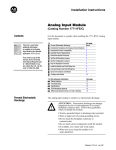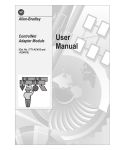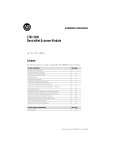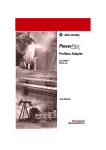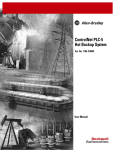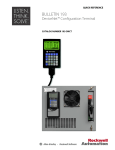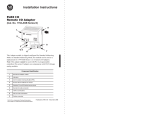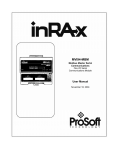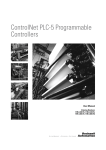Download Spec Sheet
Transcript
(Cat. No. 1747-KFC15) SLC500 ControlNet RS-232 Interface Allen-Bradley User Manual avoid the hazard recognize the consequences • • Important: Identifies information that is critical for successful application and understanding of the product. identify a hazard • Attention statements help you to: ! ATTENTION: Identifies information about practices or circumstances that can lead to personal injury or death, property damage or economic loss. Throughout this manual we use notes to make you aware of safety considerations: Reproduction of the contents of this copyrighted publication, in whole or in part, without written permission of Allen-Bradley Company, Inc., is prohibited. Due to the rapid change in technology and part availability, Allen-Bradley reserves the right to change the appearance of certain products which may not match those shown in this manual. Allen-Bradley publication SGI-1.1, Safety Guidelines for the Application, Installation, and Maintenance of Solid State Control (available from your local Allen-Bradley office), describes some important differences between solid-state equipment and electromechanical devices that should be taken into consideration when applying products such as those described in this publication. The illustrations, charts, sample programs and layout examples shown in this guide are intended solely for purposes of example. Since there are many variables and requirements associated with any particular installation, Allen-Bradley does not assume responsibility or liability (to include intellectual property liability) for actual use based upon the examples shown in this publication. Because of the variety of uses for the products described in this publication, those responsible for the application and use of this control equipment must satisfy themselves that all necessary steps have been taken to assure that each application and use meets all performance and safety requirements, including any applicable laws, regulations, codes and standards. Important User Information understand how the KFC15 module communicates on the network (procedures and protocols) troubleshoot for problems • • 1747-5.34 - June 1998 install and configure the KFC15 module • Throughout this manual we refer to the 1747-KFC15 Communication Interface as the KFC15 module. Use this manual to: Purpose of the Manual The 1747-KFC15 allows an SLC500 modular processor to communicate with the ControlNet™ network via the processor’s RS-232 serial port. Preface 1786-6.21 AG-2.2 1770-4.1 1747-5.27 Allen-Bradley ControlNet Cable System Planning and Installation Manual Allen-Bradley ControlNet Cable System Component List Allen-Bradley Industrial Automation Wiring and Grounding Guidelines SLC 5/03 and 5/04 Modular Processors Installation Instructions Allen-Bradley high voltage ac and dc type repeaters (1786-RPT and 1786-RPTD) Allen-Bradley PLC-5® processors (1785-L20C15, -L40C15, -L60C15, and -L80C15) Allen-Bradley computer interface cards (1784-KTC15 and 1784-KTCX15) Allen-Bradley 1794 FLEX I/O Adapters (1794-ACN15 and 1794-ACRN15) Allen-Bradley 1771 I/O Adapters (1771-ACN15 and 1771-ACNR15) • • • • • 1747-5.34 - June 1998 Allen-Bradley ControlNet taps (1786-TPR, 1786-TPS, 1786-TPYR and 1786-TPYS) • The KFC15 module creates an interface between the ControlNet network and an SLC500 processor. It has been verified to work with the following products: Related Products Publication Number Publication The following publications contain information related to the KFC15 module: Related Publications P-2 Network Access cable (1786-CP) • The data transmission in one direction at a time, usually point-to-multipoint. Half Duplex 1747-5.34 - June 1998 The ability to simultaneously send/receive data between devices, point-to-point. Full Duplex Allen-Bradley’s RS-232 proprietary protocol. DF1 The communication architecture that allows the exchange of messages between devices that follow the ControlNet specifications. ControlNet is a real-time, control-layer network that provides high-speed transport for both time-critical I/O and message data. A ControlNet network can be either single or redundant media. ControlNet This manual may use the following terms as defined below: Glossary of Terms and Abbreviations Other ContolNet devices and software that comply with the ControlNet Network specifications can also be used with the KFC15 module. Rockwell Software’s RSLogix500™, and RSLinx™ • P-3 1747-5.34 - June 1998 A two-port active physical layer component that reconstructs all traffic it hears on one network segment side and retransmits it to another network segment side. Repeaters allow for extensions in network distance, conversion to alternate media (coaxial cable, fiber, etc.) and altering the topology of the network. Repeater An application-level command set that Allen-Bradley programmable controllers use to communicate across networks. PCCC (Programmable Controller Communications Commands) The rate at which access to the network is granted. NUT (Network Update Time) Any physical device connecting to the ControlNet network that requires a network address in order to function on the network. Node The network address of a node on the ControlNet network. This address must be in the range of 1 to 99 (decimal) and be unique to that subnet. A subnet can contain a maximum of 99 nodes. Network Address A collection of connected nodes (end devices). The connection paths between any pair of nodes can include repeaters, routers, bridges, and gateways. Network An input/output (RJ-45 style) connector for a programming terminal to gain full access to the network. NAP (Network Access Port) P-4 A length of trunkline cable between any two taps. Trunkline Section The bus or central part of a cable system Trunkline 1747-5.34 - June 1998 A special circuit that prevents signal reflections form occurring at the end of the cable. Terminator The connection device between any device and the trunkline. A tap is required for each node and for both sides of each repeater. Tap Network segments connected by repeats to make up on ControlNet network. Subnet Input/output connector for a device that transmits data and controls bits sequentially over a single transmission line. (See RS-232C port.) Serial Port Trunkline sections connected via taps with terminators at each end, and with no repeaters. Segment A serial port that complies with accepted industry standards for serial communications connections. RS-232C Port P-5 1747-5.34 - June 1998 P-6 Interpreting the Status LEDs ................................................. 5-1 Interpreting the Dot Matrix Displays ...................................... 5-3 Chapter 5 Troubleshooting the KFC15 Module RSLinx and RSLogix500 ........................................................ 4-1 Setting the Correct Options ................................................... 4-2 Verifying the KFC and SLC Processor Communication Parameters ........................................................................... 4-3 Related Publications ............................................................. 4-4 Chapter 4 Communicating with the KFC15 Module Electrostatic Damage ............................................................ 3-2 Overview of the Installation Procedure .................................. 3-2 Connecting a Device to the Network Access Port .................. 3-3 Connecting to the ControlNet Cable System .......................... 3-4 Chapter 3 Installing the KFC15 Module Overview of Configuration Procedures ................................... 2-1 DIP Switches ........................................................................ 2-2 Configuring the KFC15 Module Using Rotary Switches .......... 2-5 Chapter 2 Configuring the KFC15 Module Overview of the 1747-KFC15 Module .................................... 1-1 Compatibility ......................................................................... 1-5 European Union Directive Compliance ................................... 1-6 CSA Hazardous Location Approval ......................................... 1-7 Approbation d’utilisation dans des emplacements dangereux par la CSA ........................................................... 1-8 Chapter 1 Introducing the 1747-KFC15 Module Table of Contents 1747-5.34 - June 1998 Diagnostic Loop ....................................................................C-2 Diagnostic Read Counters .....................................................C-2 Diagnostic Status ..................................................................C-3 Diagnostic Counter Reset ......................................................C-4 Appendix C DF1 Diagnostic Command Support Cabling and Pinouts for RS–232C Connection ........................B-1 Appendix B Cabling and Pinouts RS–232C Interface ................................................................A-1 ControlNet Interface ..............................................................A-2 Network Access Port (NAP) Interface .....................................A-2 Physical ................................................................................A-2 Environmental .......................................................................A-2 Agency Safety Certification ....................................................A-3 Appendix A Product Specifications toc-ii 1 SLC500 Processor 1747-5.34 - June 1998 30667-M The KFC15 module enables you to communicate with your SLC500 processor using a ControlNet network. You can examine the processor’s ladder program, monitor program operation, and make program changes. The KFC15 module acts as a bridge between a ControlNet network and your SLC500 processor’s RS-232C serial port. Overview of the 1747-KFC15 Module Introducing the 1747-KFC15 Module Chapter Desktop PC Laptop PC RS-232C ControlNet Network B Introducing the 1747-KFC15 Module ControlNet Network A 30668-M 1747-5.34 - June 1998 The KFC15 module connects to the ControlNet network from one (channel A) or both of its two BNC connectors via a standard, one-meter, ControlNet coaxial tap. For redundant media, both connectors are used. 1-2 1-3 RS-232C Display on the 1747-KFC15 module RS-232C 1747-5.34 - June 1998 30662-M 30665-M Status LEDs and the dot matrix display on the front of the KFC15 indicate current operating conditions of the unit and communication activities taking place through the ports. The serial port uses DF1 protocol while the network access port handles ControlNet packets directly. network access port—lets you connect a ControlNet programming terminal or other device to the KFC15 module for full network access without disrupting the cable wiring RS-232C serial port—provides half- or full-duplex communication with a serial port on your SLC500 processor. The KFC15 module has two ports for device connections: Introducing the 1747-KFC15 Module 3 Banks of DIP Switches Rotary Switches Top View of Module Introducing the 1747-KFC15 Module 30663-M 30666-M 1747-5.34 - June 1998 You use the three banks of DIP switches to configure the RS-232C serial communication parameters. Two rotary switches are available to set the ControlNet network address. To verify your settings, you can use the dot matrix display located on the front of the module. Refer to Chapter 2 and Chapter 4 for more information. 1-4 ControlNet devices that comply with the ControlNet specification Programming terminal products that comply with ControlNet specifications for the Network Access Port • • 1747-KFC15 module RS-232 cable SLC500 ControlNet RS-232 Interface User Manual (pub. no. 1747-5.34) • • • 1-5 1747-5.34 - June 1998 Make sure that you have these items before you discard any packing material. If an item is missing or incorrect, contact your local Allen-Bradley office. Contents of Your Order RS-232C serial ports that comply with DF1 protocol • The KFC15 is compatible with the following interfaces: Compatibility Introducing the 1747-KFC15 Module Introducing the 1747-KFC15 Module EN 50082-2 EMC - Generic Immunity Standard, Part 2 - Industrial Environment • 1747-5.34 - June 1998 This equipment is classified as open equipment and must be mounted in an enclosure during operation to provide safety protection. For specific information required by EN 61131-2, see the appropriate sections in this publication, as well as the Allen-Bradley Industrial Automation Wiring and Grounding Guidelines For Noise Immunity, publication 1770-4.1. This product is tested to meet Council Directive 73/23/EEC Low Voltage, by applying the safety requirements of EN 61131-2 Programmable Controllers, Part 2 - Equipment Requirements and Tests. Low Voltage Directive This product is intended for use in an industrial environment. EN 50081-2 EMC - Generic Emission Standard, Part 2 - Industrial Environment • This product is tested to meet Council Directive 89/336/EEC Electromagnetic Compatibility (EMC) and the following standards, in whole or in part, documented in a technical construction file: EMC Directive If this product has the CE mark it is approved for installation within the European Union and EEA regions. It has been designed and tested to meet the following directives. European Union Directive Compliance 1-6 1-7 CL I, DIV 2 GP A,B,C,D TEMP CL I, DIV 2 GP A,B,C,D TEMP Look for temperature code rating here. Batteries must only be changed in an area known to be non-hazardous. 1747-5.34 - June 1998 Do not disconnect connectors unless power has been switched off or the area is known to be nonhazardous. Secure any user-supplied connectors that mate to external circuits on this equipment by using screws, sliding latches, threaded connectors, or other means such that any connection can withstand a 15 Newton (3.4 lb.) separating force applied for a minimum of one minute. Do not disconnect equipment unless power has been switched off or the area is known to be nonhazardous. Do not replace components unless power has been switched off or the area is known to be nonhazardous. Substitution of components may impair suitability for Class I, Division 2. CSA logo is a registered trademark of the Canadian Standards Association. • • • • • WARNING: Explosion hazard-- The following warnings apply to products having CSA certification for use in hazardous locations. Temperature code rating: Due to the modular nature of a programmable control system, the product with the highest temperature rating determines the overall temperature code rating of a programmable control system in a Class I, Division 2, location. The temperature code rating is marked on the product label as shown. The products having the appropriate CSA markings (that is, Class I, Division 2, Groups A, B, C, D) are certified for use in other equipment where the suitability of combination (that is, application or use) is determined by the CSA or the local inspection office having jurisdiction. This equipment is suitable for use in Class I, Division 2, Groups A, B, C, D, or non-hazardous locations only. Important: • • To comply with CSA certification for use in hazardous locations, the following information becomes a part of the product literature for this CSA-certified industrial control product. Example of the CSA certification product label: CSA certifies products for general use as well as for use in hazardous locations. Actual CSA certification is indicated by the product label as shown below, and not by statements in any user documentation. CSA Hazardous Location Approval Introducing the 1747-KFC15 Module Introducing the 1747-KFC15 Module CL I, DIV 2 GP A,B,C,D TEMP CL I, DIV 2 GP A,B,C,D TEMP Le taux du code de température est indiqué ici. Afin d'éviter tout risque d'explosion, s'assurer que l'emplacement est désigné non dangereux avant de changer la batterie. Avant de débrancher les connecteurs, couper le courant ou s'assurer que l'emplacement est reconnu non dangereux. Attacher tous connecteurs fournis par l'utilisateur et reliés aux circuits externes de cet appareil à l 'aide de vis, loquets coulissants, connecteurs filetés ou autres moyens permettant aux connexions de résister à une force de séparation de 15 Newtons (3,4 lb. - 1,5 kg) appliquée pendant au moins une minute. Avant de débrancher l'équipement, couper le courant ou s'assurer que l'emplacement est désigné non dangereux. Couper le courant ou s'assurer quel'emplacement est désigné non dangereux avant de remplacer lescomposants. 1747-5.34 - June 1998 Le sigle CSA est la marque déposée de l'Association des Standards pour le Canada. • • • • Les avertissements suivants s’appliquent aux produits ayant la certification CSA pour leur utilisation dans des emplacements dangereux. AVERTISSEMENT: Risque d’explosion -• La substitution de composants peut rendre ce matériel inacceptable pour lesemplacements de Classe I, Division 2. Taux du code de température: Par suite de la nature modulaire du système de contrôle programmable, le produit ayant le taux le plus élevé de temperature détermine le taux d'ensemble du code de température du système de contrôle d'un programmable dans un emplacement de Classe 1, Division 2. Le taux du code de température est indiqué sur l'étiquette du produit. Les produits portant le marquage approprié de la CSA (c'est à dire, Classe 1, Division 2, Groupes A, B, C, D) sont certifies a l'utilisation pour d'autres équipements où la convenance de combinaison (application ou utilisation) est déterminée par la CSA ou le bureau local d'inspection qualifié. Cet équipement convient à l'utilisation dans des emplacements de Classe 1, Division 2, Groupes A, B, C, D, ou ne convient qu'à l'utilisation dans des endroits non dangereux. Important: • • Pour satisfaire à la certification de la CSA dans des endroits dangereux, les informations suivantes font partie intégrante de la documentation ce produit industriel de contrôle certifié par la CSA. Exemple d'étiquette de certification d'un produit par la CSA: La CSA certifie les produits d'utilisation générale aussi bien que ceux qui s'utilisent dans des emplacements dangereux. La certification CSA en vigueur est indiquée par l'étiquette du produit et non par des affirmations dans la documentation à l'usage des utilisateurs. Approbation d’utilisation dans des emplacements dangereux par la CSA 1-8 2 1747-5.34 - June 1998 Refer to Chapter 4 for information on configuring the communication between the SLC500 and the KFC15 modules. The KFC15 module is configured by using the DIP and rotary switches located on the module. These two types of switches configure the RS-232 serial communication parameters, and the network address. During configuration, the module must not be powered. Once the switches are set, the module can then be installed in the SLC chassis. Located on the front of the KFC module is a dot matrix display, which you can use to verify your settings. Refer to Chapter 5 for more information on the dot matrix display. Overview of Configuration Procedures Use this chapter to configure the KFC15 communication parameters via the DIP switches and rotary switches on the module. Configuring the KFC15 Module Chapter 30663-M S2 S3 1747-5.34 - June 1998 Important: Do not use a pencil because the tip can break off and short the switch. Use a ball-point pen to set any of the switches within the three banks to on or off. Important: The communication parameters between the SLC500 and the KFC15 must be identical. Refer to Chapter 4 for more information. Located within the body of the 1747-KFC15 module are three banks (S1, S2, and S3) of eight DIP switches. These switches are used to configure the RS-232 serial communication port. The white area indicates the position of the switch specified as on. 1 2 34 5 6 7 8 ON S1 Configuring the KFC15 Module DIP Switches 2-2 2-3 Lower digit of DF1 station address Switches 4-6 Leave off Description SW 1/4 on off on off on off on off SW 2/5 on on off off on on off off SW 3/6 on on on on off off off off off = Full duplex (default) on = Half duplex off = No parity (default) on = See switch 6 off = Odd parity on = Even parity off = No handshake (default) on = Hardware handshake enable off = Disabled (default) on = Enabled Serial Port Baud Rate Full/Half duplex Parity Odd/Even parity (when used with Switch 5) Handshake Diagnostic Command Execution Switch 4 Switch 5 Switch 6 Switch 7 Switch 8 Baud Rate 1200 (default) 2400 4800 9600 19200 38400 57600 Reserved Digit 0 1 2 3 4 5 6 7 (default) 1747-5.34 - June 1998 Switch 3 off on off on off on off on Switches 1-3 Switch 2 off off on on off off on on Description Switch 1 off off off off on on on on Parameters DIP Switch Table 2-2: Bank S2 DIP Switches Upper digit of the DF1 station address Switches 1-3 Switches 7-8 Parameter DIP Switch Table 2-1: Bank S1 DIP Switches Documented in the tables below are the DIP switches, the bank in which they are located, and the parameters controlled by each switch. Configuring the KFC15 Module Error detect Number of retries DF1 ACK time-out Switch 2 Switch 3-4 Switch 5-8 1747-5.34 - June 1998 off = Duplicate detect off (default) on = Duplicate detect on Duplicate detect Switch 1 The time to wait for an ACK from the host computer. on off on off on off on off on off on off on off on off on on off off on on off off on on off off on on off off off = CRC error check (default) on = BCC error check SW3 SW4 Number of on on allowable off on retries per on off attempt on the off off RS-232C link: 00 - 07 SW5 SW6 Description Parameter on on on on off off off off on on on on off off off off SW7 Table 2-3: Bank S3 DIP Switches Configuring the KFC15 Module DIP Switch 2-4 on on on on on on on on off off off off off off off off SW8 Time Out .2 .4 .6 .8 1.0 1.2 1.4 1.6 1.8 2.0 2.2 2.4 2.6 2.8 3.0 3.2 (default) Number of retries 0 1 2 3 (default) 2-5 Rotary Switches S5 and S4 respectively S5 S4 1747-5.34 - June 1998 The KFC15’s ControlNet network address is set by the rotary switches S4 and S5. Switch S5 sets the upper digit of the address and S4 the lower. These switches can be turned manually by hand while holding the module in the orientation illustrated below. Configuring the KFC15 Module Using Rotary Switches Configuring the KFC15 Module Configuring the KFC15 Module 1747-5.34 - June 1998 2-6 3 how to connect the KFC15 module to your SLC500 processor through the RS-232C serial port how to connect the KFC15 module to a host through the isolated network access port (NAP) how to connect the KFC15 module to the ControlNet network • • • 1784-5.34 - June 1998 If you have attempted to install the KFC15 module and still have questions, please call Rockwell Automation Technical Support at (440) 646-6800. Pinout and wiring details are provided in Appendix B, Cabling and Pinouts. Read this if you need to construct cables. If a tap is not available on the ControlNet network for the KFC15 module, refer to the ControlNet Cable System Planning and Installation Manual (pub. no. 1786-6.2.1) to determine if your cable system can accommodate another node and to plan where to mount the tap, then follow the mounting instructions at the end of this chapter. an overview of the general installation procedure • Use this chapter to install the KFC15 module. This chapter describes: Installing the KFC15 Module Chapter Installing the KFC15 Module 1747-5.34 - June 1998 5. Connect the KFC15 to the ControlNet network using taps. 4. Install the KFC15 module into an empty I/O slot. The 1747-KFC15 module must be placed near the SLC processor. In a large chassis, any empty slot will not work. 3. Remove power from your SLC500 chassis. 2. Make sure that the ControlNet cable system can accommodate additional nodes (one per KFC15 module being installed). 1. Configure the communications parameters by setting the rotary and DIP switches on the KFC15 as detailed in Chapter 2, Configuring the KFC15 Module. Remember that the RS-232 serial communication parameters must be the same between the KFC15 and the SLC500. Refer to Chapter 4 for more information. Overview of the Installation Procedure ! ATTENTION: Electrostatic discharge can damage semiconductor devices inside the KFC15 module. To guard against electrostatic damage wear an approved wrist strap grounding device, or touch a grounded object to rid yourself of electrostatic charge before handling the products. Electrostatic Damage 3-2 3-3 30664-M You must use the Allen-Bradley Network Access cable (cat. no. 1786-CP). Cables 1784-5.34 - June 1998 Use the isolated network access port to connect a transitory device, such as a programming device, to the KFC15 module. Connecting a Device to the Network Access Port 7. Apply power to your SLC500 chassis. RS-232 cable 6. Connect the KFC15 module to your SLC500 processor with the supplied RS-232 cable. Installing the KFC15 Module Installing the KFC15 Module 1747-5.34 - June 1998 3. If using redundant media, repeat either step 1 or step 2 for channel B of the KFC15 module. 2. If the KFC15 module is the last device in the segment, install a terminator at the end of the cable segment, then follow the instructions in step 1. • Connect the dropline BNC to the channel A BNC of the KFC15 module. • Connect the tap to the coaxial trunkline. 1. If the KFC15 module is not the last device in the segment: To connect the KFC15 module to the tap do the following: ! ATTENTION: If the KFC15 module is connected to a cable system that does not support redundant media, the tap dropline should be connected to the BNC connector labeled channel A. The channel B connector should be unused. If the cable system is redundant, the KFC15 module should be connected such that all devices on the network use the same cable for the same channel. The channel A connector on all products should be connected to the same cable. The same applies for the channel B connectors. To connect the KFC15 to the ControlNet cable system use an approved ControlNet tap. Refer to the ControlNet Cable System Planning and Installation Manual (pub. no. 1786-6.2.1) for complete instructions on connecting the tap to the cable system. Connecting to the ControlNet Cable System 3-4 4 1747-5.34 - June 1998 To use your KFC15 module to communicate with your SLC500 processor, you must have RSLinx and RSLogix500 installed on your personal computer, along with an add-on module or communication card to communication between your PC and the ControlNet network. Examples of add-on modules for this type of configuration are the 1784-KTCX15, 1770-KFC15, and the 1784-PCC. RSLinx and RSLogix500 This chapter explains how to use your 1747-KFC15 module to communicate with your SLC500 processor. Communicating with the KFC15 Module Chapter Communicating with the KFC15 Module 1747-5.34 - June 1998 2. Select System Comms from the pop-up menu. A dialog box is displayed. 1. Start RSLogix500 and choose Comms from the menu. To communicate with your SLC500 processor, using RSLogix500, perform the following: Setting the Correct Options 4-2 4-3 1747-5.34 - June 1998 5. When the dialog box appears, select SLC-CH0/Micro/Panelview from the Device Type list. 4. When the dialog box appears, choose RS232 DF1 Devices from the Available Drivers list. Click on the Add New pushbutton. 3. From the menu bar choose Communications, then Configure Drivers. 2. Start RSLinx. 1. Connect a serial cable from one of the communication ports on your computer to the SLC500 processor’s serial port. Determine the Serial Parameters for the SLC Processor Both the SLC500 and the 1747-KFC15 RS-232 serial communication parameters need to be identical for proper communication. The default DIP switch settings for the KFC15 are the same default settings used for the SLC500. Only if you have changed the SLC500 settings do you need to modify the settings for the KFC15. Below are the steps, performed in RSLinx, to verify the parameters between the two modules. Verifying the KFC and SLC Processor Communication Parameters At this point you should be able to go on-line with your SLC500 processor. 5. Within the Processor Node field, enter the 1747-KFC15 ControlNet network address displaying on the KFC15 module. If you are unsure, remember the network address is set by the rotary switches on the KFC15 module. Refer to Chapter 2 for more information. 4. From the Driver field, choose the appropriate driver for the add-on module you are using from the drop-down list that was used to configure RSLinx for communications on the ControlNet network. 3. Select the System Communications tab. Communicating with the KFC15 Module Communicating with the KFC15 Module Getting Results with RSLogix500 with RSNetworks for ControlNet pub. no. 9399-RWCNPGR Getting Results with RSLogix500 - pub. no. 9399-RL50GR Getting Results with RSLinx - pub. no. 9399-WAB32GR • • • 1747-5.34 - June 1998 Getting Results with RSNetworks for ControlNet pub. no. 9399-CNETGR • Listed below are publications you can reference for information about RSLogix500 and RSLinx. Related Publications Once you have confirmed the communication settings for the SLC500, you can use the dot matrix display on the KFC15 to verify the settings are the same. Refer to Chapter 5 for information on interpreting the display. If you are unsure, you can check the three DIP switch banks on the KFC15 module for the particular settings. 6. Select the Auto-Configure pushbutton to obtain the serial parameters. 4-4 5 RS-232C 30662-M 30665-M Display on the 1747-KFC15 module 1747-5.34 - June 1998 RS-232C There are three, bi-color (red/green) status LEDs on the top of the KFC15 module. Two are for ControlNet, showing the physical layer status of channels A (primary connection) and B (redundant media connection), and one is for the KFC15 (STATUS). These indicators can help you diagnose problems with the module’s installation and operation. Interpreting the Status LEDs Use this chapter to interpret the indicators (status LEDs and dot matrix display) on the KFC15 module to help you troubleshoot problems. Troubleshooting the KFC15 Module Chapter Troubleshooting the KFC15 Module No power or reset Failed unit Probable Cause (duplicate node, ID, etc.) RAILROAD RED - Self test GREEN RAILROAD RED - Incorrect node OFF configuration OFF SOLID RED State 1747-5.34 - June 1998 Channels A and B (viewed together) LED Check network address and other ControlNet configuration parameters. Check network setup then cycle power to the KFC15 module. If the fault persists, contact your authorized Allen-Bradley representative or distributor. None Recommended Action flickering - intermittent on/off between the two states, often in an erratic pattern railroad - both LEDs alternate between the two defined states at the same time. This only applies to both ControlNet LEDs when viewed together. The two LEDs are always in opposite states (out-of-phase). flashing - each LED alternates between the two defined states (or with OFF if only one state is defined). This only applies to a single LED viewed independently of the other. If both ControlNet LEDs are flashing, they flash together (in phase). solid - on continuously in the defined state The following terms are used to describe the state of the LEDs: 5-2 Reconfigure or reset the KFC15. Check and change parameter settings. Contact your authorized AllenBradley representative or distributor. None Check network setup then cycle power to the KFC15 module. Check media for broken cables, loose connector, missing terminators, etc. None None. Unit will correct itself. Program network for redundant media if required. None Recommended Action 5-3 1747-5.34 - June 1998 Under normal conditions, the dot matrix display should be displaying the ControlNet network address as well as the ControlNet network status. During operation, the dot matrix display is used to indicate hardware fault conditions. When the STATUS LED is solid or flashing red, the display shows a number indicating the type of hardware fault. The following table gives a description of the faults. Interpreting the Dot Matrix Displays STATUS Probable Cause Channel disabled or unused Channel good—data is being received and transmitted on this channel FLASHING Temporary errors or GREEN - OFF device is not on-line FLASHING RED - Bad network GREEN configuration FLASHING RED - Media fault or no other OFF nodes present on the network OFF No power is applied to the KFC15 module SOLID GREEN Normal operation—the module is OK FLASHING The KFC15 is not GREEN properly configured SOLID RED Critical fault—the KFC15 has detected an unrecoverable fault and must be replaced FLASHING RED Non-critical fault—the KFC15 has detected a recoverable fault State Channel A or OFF B (viewed separately) SOLID GREEN LED Troubleshooting the KFC15 Module Invalid Firmware Firmware Checksum Fault RAM Fault Flash EPROM Write Fault Invalid Network Address Duplicate Network Address Unrecoverable Firmware Error 2 3 5 9 This is a major fault. Return the KFC15 for servicing. The chosen network address is greater than the highest network address ControlNet is configured for. There is a device on the ControlNet network with the same address. Failed to re-program the boot block of the Flash EPROM. Return the KFC15 module for servicing. If the problem persists, return the KFC15 for servicing. The Flash EPROM could not be programmed correctly during download of new firmware. This is a major fault. Return the KFC15 for servicing. The Flash EPROM does not contain valid firmware. New firmware must be downloaded to the unit. A checksum error was detected in the main application code of the Flash EPROM. The static RAM cannot be written to reliably or a parity error has occurred. Cycle power to the KFC15. A hardware fault was detected in the processor. Meaning 1747-5.34 - June 1998 During the power-up of the KFC15, the display shows the serial port parameters based on the DIP switch settings. Refer to Chapter 2 for details on these parameters. If the displays show symbols other than those shown in this chapter, this also indicates that the module is malfunctioning. In this case, contact your Allen-Bradley representative. 11 10 4 Processor Fault Indicates this fault Troubleshooting the KFC15 Module 1 This number 5-4 Start Bits Data Bits Parity Stop Bits Baud Rates Connector Output Protocol Cable Length Cable Type Ground Isolation • • • • • • • • • • • RS-232C Interface A 1747-5.34 - June 1998 Opto-coupled Shielded Recommended maximum of 7.5 m (25 ft) at 57600 baud, or 15 m (50 ft) at lower baud rates Allen-Bradley DF1 RS-232C DB-9P (male) 9600,19200, 38400, 57600 1200, 2400, 4800, 1 None, Even, Odd 8 1 Product Specifications Appendix Product Specifications Cable Media Redundancy Ground Isolation • • • Dual transformers Connection for 2 independent coaxial cables RG-6 75-ohm coaxial cable Standard BNC Connectors Ground Isolation • 217.6 g SLC500 chassis • Weight • Mounting –40°C to 85°C (–40° to 185°F) 5% to 95% (non-condensing) • Storage Temperature • Operating Humidity 1747-5.34 - June 1998 0°C to 60°C (32°F to 140°F) • Operating Temperature Environmental 140 cm wide x 145 cm long x 35 cm high Opto-coupled RJ-45 8-pin, phone jack with shield • Dimensions Physical Connector • Network Access Port (NAP) Interface Connectors • ControlNet Interface A-2 Listed Compliant for all application directives • UL • CE 1747-5.34 - June 1998 Approved. Class 1, Group A, B, C or D Division 2 A-3 • CSA Agency Safety Certification Product Specifications Product Specifications 1747-5.34 - June 1998 A-4 B GND TXD RXD RTS CTS DSR COM DCD DTR Chassis ground Transmitted data Received data Request to send Clear to send Data set ready Signal common Data carrier detect Data terminal ready Signal . O I O I I . I O I/O 1747-5.34 - June 1998 Housing 3 2 7 8 6 5 1 4 Pin The KFC15 RS-232C connector is a DB-9 male with the following EIA standard pinout: Cabling and Pinouts for RS-232C Connection This appendix contains the pinout and wiring information required if you need to construct cables before installing the KFC15 to a host device. Cabling and Pinouts Appendix Cabling and Pinouts 3 4 5 6 7 8 9 2 6 5 4 8 7 9 3 TXD 8 CTS 7 RTS 5 GND 4 DTR 6 DSR 1 DCD RXD 2 RTS 7 CTS 8 GND 5 DSR 6 DCD 1 1747-5.34 - June 1998 DTR 4 2 RXD Shield KFC15 TXD 3 SLC500 The following diagram illustrates the handshake wiring between the SLC500 and the KFC15. Shield 2 3 Shield I 9P R/A D-Shell I 9P R/A D-Shell The following diagram illustrates wiring for a DB-9 cable. B-2 C 06 06 06 06 00 01 03 07 Function Code (hex) TNS - transaction number STS - status code FNC - function code CMD - command code ADDR - address of data to be read 1747-5.34 - June 1998 In the Command and Reply Format tables below, all values are in hex and the following abbreviations are used: Command Byte Description Diagnostic Loop Diagnostic Read Counters Diagnostic Status Reset Diagnostic Counters The information in this appendix deals with DF1 communications between the host processor and KFC15 module. The KFC15 module interprets and responds to the following diagnostic commands from its DF1 RS-232 serial port: DF1 Diagnostic Command Support Appendix DF1 Diagnostic Command Support FNC 00 1 byte TNS STS DATA 243 bytes max DATA 243 bytes max TNS STS 1 byte FNC 01 2 bytes TNS 1 byte STS Table C.4: Reply Format 2 bytes 1 byte 1747-5.34 - June 1998 1 byte CMD 46 1 byte CMD 06 2 bytes ADDR 0000 Table C.3: Command Format DATA 16 bytes 1 byte SIZE 00 This command reads the diagnostic counters from the KFC15 module. The format of these counters is given below. The address and size fields can have any value (but they must be included). Diagnostic Read Counters 2 bytes Table C.2: Reply Format TNS 2 bytes 1 byte STS CMD 06 1 byte CMD 46 1 byte 1 byte Table C.1: Command Format You can use this command to check the integrity of the transmissions over the communication link. The command message transmits up to 243 bytes of data to a node interface module. The receiving module should reply to this command by transmitting the same data back to the originating node. Diagnostic Loop C-2 Total DF1 packets received, low byte Total DF1 packets received, high byte Total DF1 packets transmitted, low byte Total DF1 packets transmitted, high byte Number of DF1 retries Number of DF1 packets where the retry limit was exceeded Number of DF1 NAKs sent Number of DF1 NAKs received Number of DF1 bad messages received Number of RS–232C line errors Total good ControlNet packets received, low byte Total good ControlNet packets received, high byte Total bad ControlNet packets received, low byte Total bad ControlNet packets received, high byte Total ControlNet packets transmitted, low byte Total ControlNet packets transmitted, high byte C-3 1 byte CMD 46 1 byte CMD 06 TNS STS 2 bytes TNS 1 byte STS Table C.7: Reply Format 2 bytes 1 byte Table C.6: Command Format 1784-5.34 - June 1998 DATA 24 bytes 1 byte FNC 03 This command requests a block of status information from an RS-232C device. The reply contains the information in its DATA field. The status information varies from device to device. The status block is shown below. Diagnostic Status 1 2 3 4 5 6 7 8 9 10 11 12 13 14 15 16 Table C.5: Reply Values DF1 Diagnostic Command Support ASCII Reserved for factory use only Bulletin Name = Bits 5–7: Bits 0–4: Series/Revision (F = Computer) Extended Interface Type On-line/Off-line Mode Bits 4 – 7: Processor type (E = Extended) Bits 0 – 3: Interface type Description Mode/Status Byte Interface/Processor Type 1747-5.34 - June 1998 1 byte CMD 06 2 bytes TNS 1 byte STS Table C.9: Command Format 1 byte FNC 07 This command resets the diagnostic counters listed above. Values may vary “1770-KFC15 ” “1770-KFCD15 ” 1 = Series B, etc. 0 = Series A 1 = Revision B, etc. 0 = Revision A 5F (KFC15) 60 (KFCD15) 0 = on-line; 1 = off-line FE (Extended) Status Reply 00 (No Modes) Table C.8: Reply Values DF1 Diagnostic Command Support Diagnostic Counter Reset 17 – 24 6 – 16 5 3 4 2 Data Byte 1 C-4 1 byte CMD 46 2 bytes TNS 1 byte STS Table C.10: Reply Format C-5 1784-5.34 - June 1998 DF1 Diagnostic Command Support DF1 Diagnostic Command Support 1747-5.34 - June 1998 C-6 N LEDs 1-3 flashing 5-2 flickering 5-2 interpreting 5-1 railroad 5-2 solid 5-2 L Installation Procedure 3-2 I SLC500 1-1, 4-1 1747-5.34-June 1998 rotary switch settings 2-5 Rotary Switches S4, S5 2-5 RS-232C serial port 1-1, 1-3, 1-4, 1-5, 3-1, A-1, B-1 connecting to host B-1 RSLinx 4-1 RSLogix500 4-1 DF1 1-3 commands from host C-1 DF1 diagnostic command support C-1 diagnostic counter reset C-4 diagnostic loop C-2 diagnostic read counters C-2 diagnostic status C-3 DIP switches Bank S1 DIP Switches 2-3 Bank S2 DIP Switches 2-3 Bank S3 DIP Switches 2-4 S1, S2, S3 2-2 dot matrix display interpretation table 5-4 S R product specifications A-1 P network access cable 3-3 network access port 1-3, 1-5, 31, A-2 1786-CP 3-3 table of 5-2 D Cabling and Pinouts B-1 Compatibility 1-5 Connecting to the ControlNet Cable System 3-4 ControlNet interface A-2 C agency safety certification A-3 A Index-1 1747-5.34 - June 1998 Index-2 Please contact your local Rockwell Automation representative for any technical support issues. Outside United States Supersedes Publication 1747-IN006A-US-P - February 2000 Copyright © 2007 Rockwell Automation, Inc. All rights reserved. Printed in Singapore. PN 955132-68 Please contact your local Rockwell Automation representative for return procedure. Outside United States Publication 1747-5.34 - June 1998 Contact your distributor. You must provide a Customer Support case number (see phone number above to obtain one) to your distributor in order to complete the return process. United States Rockwell tests all of its products to ensure that they are fully operational when shipped from the manufacturing facility. However, if your product is not functioning, it may need to be returned. New Product Satisfaction Return 1.440.646.3223 Monday – Friday, 8am – 5pm EST United States If you experience a problem with a hardware module within the first 24 hours of installation, please review the information that's contained in this manual. You can also contact a special Customer Support number for initial help in getting your module up and running. Installation Assistance For an additional level of technical phone support for installation, configuration, and troubleshooting, we offer TechConnect Support programs. For more information, contact your local distributor or Rockwell Automation representative, or visit http://support.rockwellautomation.com. Rockwell Automation provides technical information on the Web to assist you in using its products. At http://support.rockwellautomation.com, you can find technical manuals, a knowledge base of FAQs, technical and application notes, sample code and links to software service packs, and a MySupport feature that you can customize to make the best use of these tools. Rockwell Automation Support




















































